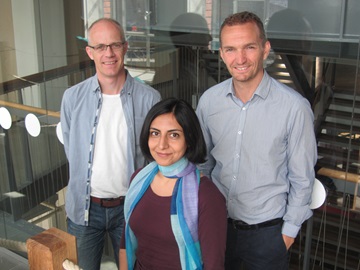 With an article published in the Proceedings of the National Academy of Science in the United States of America (PNAS), a thirteen-year-long mystery that has involved a long series of researchers at both Linköping University and Acreo Swedish ICT has finally been solved.
With an article published in the Proceedings of the National Academy of Science in the United States of America (PNAS), a thirteen-year-long mystery that has involved a long series of researchers at both Linköping University and Acreo Swedish ICT has finally been solved.The article presents a diode in printed electronics that works in the GHz band, which opens up a new opportunity to send signals from a mobile phone to, for example, printed electronic labels. Energy from the radio signal is collected and used to switch the label’s display. The diode being printed means that it is both cheap and simple to manufacture.
A new role for mobile phones
“This means that we can supply power to printed electronics within the ‘internet of things’ with the help of conventional mobile phones. This gives us new opportunities for communications,” says Negar Sani, PhD student at the Laboratory for Organic Electronics at Linköping University.Researchers have long known that the diode works, but not how and why.
In 2001, Petronella Norberg at Acreo Swedish ICT, laid a disc of silicon in a mortar, ground it down and produced a silicon paste that she then used as ink in a printing press. She produced a functional printed diode – the electronic key component that, among other things, converts alternating current to direct current. But the diode only worked up to 1 MHz, and no immediate field of use could be found.
At Acreo Swedish ICT, a research team funded by the British company De La Rue, worked for several years on developing both the diode and new printing pastes. With a paste containing the transition metal niobium, in the form of niobium silicide, NbSi2, printed over the silicon paste, they got the whole thing to work at GHz as well.
World record in printed diodes
“The results meant a world record for printed diodes, and we were also able to manufacture a demonstrator for De La Rue where the signal from a mobile phone was used to activate a printed display. We had demonstrated that it was possible to link paper to the Internet,” says Göran Gustafsson, department head at Acreo Swedish ICT. Foto: Monica Westman
Foto: Monica WestmanBut still nobody knew how the diode worked.
Ms Sani has now taken the last decisive step toward solving the puzzle, naturally with the help of Professors Magnus Berggren and Xavier Crispin as well as Senior Lecturer and Project Manager Isak Engquist, and a number of people at Acreo Swedish ICT. The results of Ms Sani’s work showed that it must have to do with tunnel effects, a phenomenon in quantum physics that makes it so that particles can get past obstacles. In this case, nano-thin films (1–10 2 nm) are formed around the micrometer-sized grains of silicon, where the current between anodes (aluminium) and cathodes (silver and carbon) pass through, but only in one direction.
Thirteen years of work got an explanation – one that the editorial board of PNAS finally approved after more than five months of hard review by experts from various fields.
“This is the longest project I’ve worked on. What research sponsor wants to wait 13 years for publication? Without industry – De La Rue, in this case – we’d never have come this far. Now printed electronics are starting to get the same performance as traditional electronics, and this is another example of the fruitful combination of our research, developments at Acreo and needs from the industry,” says Magnus Berggren, professor of Organic Electronics at Linköping University.
An all-printed diode operating at 1.6 GHz, PNAS July 7, 2014
The authors are from the Department of Science and Technology, LiU Campus Norrköping; Acreo Swedish ICT, Campus Norrköping; De La Rue LC, United Kingdom; the Department of Physics, Chemistry and Biology, LiU Campus Valla; and Hesselblom Innovation & Development in Huddinge.
The video shows how a printed label picks up the radio signal from a telephone making a call, and uses the energy to switch the integrated display. This is only possible if there is a diode with GHz capacity that can rectify the signal.
Research highlight in Nature
2014-07-07


